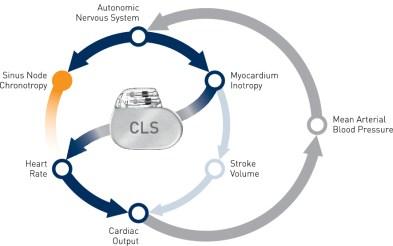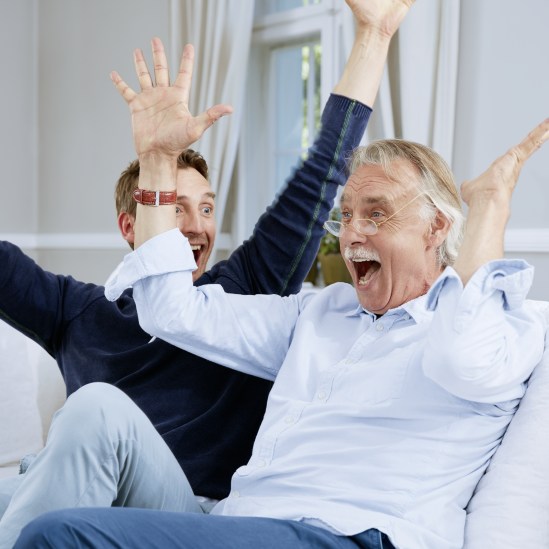Worauf basiert CLS?
Die CLS misst die Kontraktionsdynamik des Herzmuskels und ist dadurch in den kardiovaskulären Regelkreis integriert.
Die myokardiale Kontraktilität wird von denselben neuralen und humoralen Mechanismen gesteuert wie der Sinusknoten.
Veränderungen der intrakardialen Impedanz sind eine Folge einer erhöhten oder verringerten Kontraktilität und bilden daher die Grundlage für eine echte physiologische Frequenzregelung durch die Closed-Loop-
Stimulation.
Die CLS ist der einzige Sensor, der bei physischer und/oder mentaler Belastung eine physiologische Frequenzadaption bietet.

Wie genau funktioniert CLS ?
Zunächst wird eine Ruhekurve erstellt:
CLS misst die intrakardiale Impedanz bei JEDER einzelnen Kontraktion der Herzkammer.
Mehrere unterschwellige Messimpulse zwischen Elektrodenspitze und Gehäuse ergeben den Impedanzverlauf während der Systole (Messung der Kontraktionsdynamik).
Im „Ruhezustand“ (akzelerometrisch überwacht) ergeben die Impedanzwerte eine kontinuierlich aktualisierte Referenzkurve, welche die Kontraktionsdynamik in Ruhe wiedergibt. Diese Referenzkurve setzt
sich aus den letzten 256 Ruhekurven der Stimulations- und Detektionsereignisse zusammen, um Schwankungen durch die Atmung auszugleichen.
Bei Belastung wird dann die aktuelle Kurve mit der Ruhekurve verglichen:
Bei jedem Herzschlag ermittelt CLS die Impedanzkurve während der Systole und vergleicht sie mit der Referenz-Ruhekurve.
Geringe Abweichungen zwischen der Referenzkurve und der nächsten Belastungskurve führen zu einer minimalen Frequenzadaption.
Moderate Abweichungen zwischen der Referenzkurve und der nächsten Belastungskurve führen zu einer moderaten Zunahme der Herzfrequenz.
Große Abweichungen zwischen der Referenzkurve und der nächsten Belastungskurve führen zu einer Frequenzadaptation bis zur maximalen CLS-Frequenz.
Die CLS erfordert keine speziellen Elektroden oder Fixierungspositionen zur Messung der Kontraktionsdynamik. Die CLS reagiert angemessen, auch wenn die Elektrode im oberen Teil des Septums oder im Ausflusstrakt
positioniert ist.
Die Funktion von CLS wurde in vielen Studien belegt:
Witte J.et al., EUR JCPE 1996
“ANS-Controlled Rate-Adaptive Pacing A Clinical Evaluation”
Res JCJ et Al., PROGRESS IN BIOMEDICAL RESEARCH 1997
“Dual chamber pacing and closed-loop regulation – Clinical results”
Malinowski K. et al., PACE 1998
“Interindividual Comparison of different sensor principles for rate adaptive pacing”
Clementy J. et al., AMERICAN JOURNAL OF CARDIOLOGY 1999
“Evaluation of the Chronotropic Function of a Closed-Loop Rate-Responsive Dual Chamber Pacemaker Driven by Contractility”
Zecchi P. et al., PROGRESS IN BIOMEDICAL RESEARCH 2000
“Closed Loop Stimulation vs. Conventional DDDR Pacing: Benefits of Hemodynamic Pacing”
Zecchi P. et al., PROGRESS IN BIOMEDICAL RESEARCH 2000
“Clinical Benefits of Closed Loop Stimulation Preliminary Results of an Intensive Validation Study”
Osswald S. et al., PROGRESS IN BIOMEDICAL RESEARCH 2002
“The CLEAR Multicenter Study Concept: Comparing Closed Loop Stimulation and Accelerometer Rate-Adaptive Pacing”
Martinelli Filho M., PROGRESS IN BIOMEDICAL RESEARCH 2001
“Cardiac Pacemakers Controlled by Autonomic Nervous System-Driven Sensor and Related Neurohumoral Aspects”
Vijay N. et al., PROGRESS IN BIOMEDICAL RESEARCH 2001
“A prospective Multicenter Study Demonstrating Safety and Effectiveness of Closed Loop Stimulation”
Griesbach L et al., PACE 2003
“Clinical Performance of Automatic Closed-Loop Stimulation Systems”
Griesbach L. et al., PACE 2003
“Restoration of Circadian Variation and Physiologic Rate Behaviour through Closed Loop Stimulation: RAPID Study Findings”
Pavri B.B. et al., CIRCULATION 2006
“An Impedance Sensor (CLS) is Superior to an Accelerometer for Chronotropically Incompetent Patients with Sinus Node Dysfunction:
Results of a Pilot Study with a Dual Sensor Pacemaker”
Neelagaru S. et al., CIRCULATION 2006
“Increased Heart Rate during Acute Mental Stress with Closed Loop Stimulation: The Emotional Response 2 Study”
Chandiramani S et al., PACE 2007
“Heart Rate Changes during Acute Mental Stress with Closed Loop Stimulation: Report on Two Single-Blinded, Pacemaker Studies.”
Coenen M. et al., EUROPACE 2008
“Closed Loop Stimulation and Accelerometer- Based Rate Adaptation: Results of the PROVIDE Study”
Lindovskà M. et al., EUROPACE 2012
“Clinical observations with Closed Loop Stimulation pacemakers in a large patient cohort: the CYLOS routine documentation registry (RECORD)”
Proietti R. et al., PACE 2012
“Closed Loop Stimulation is Effective in Improving Heart Rate and Blood Pressure Response to Mental Stress:
Report of a Single-Chamber Pacemaker Study in Patients with Chronotropic Incompetent Atrial Fibrillation”
Zecchi P. et al., PROGRESS IN BIOMEDICAL RESEARCH 2000
Closed Loop Stimulation: A New Philosophy of Pacing”
Santini M. et al., PACE 2004
“Effect of autonomic stressors on rate control in Pacemaker using ventricular impedance signal”7
Cron TA. et al., PACE 2003
“Rate responsive of a closed-loop stimulation pacing system to changing preload and afterload conditions”
Abi-Samra F.D. et al., EUROPACE 2013
“Effect of rate-adaptive pacing on performance and physiological parameters during activities of daily living in the elderly:
results from the CLEAR (Cylos Responds with Physiologic Rate Changes during Daily Activities) study”
Drug response
Osswald S. et al., PACE 2000
“Closed-loop stimulation using intracardiac impedances as a sensor principle: correlation of right ventricular dP/dt and intracardiac impedance during dobutamine stress test”
Wojciechowski D. et al., PROGRESS IN BIOMEDICAL RESEARCH 2001
“Clinical Results of Contractility-Based Closed Loop Stimulation in Patients Treated with Beta-Blockers”
Haemodynamic benefits
Ravazzi A.P. et al., PROGRESS IN BIOMEDICAL RESEARCH 2000
“Clinical Assessment of the Correlation Between Right Ventricular Impedance and Left Ventricular Contractility”
Quaglione R et al., PACE 2009
“Autonomic Function during Closed Loop Stimulation and Fixed Rate Pacing: Heart Rate Variability Analysis from 24-Hour Holter Recordings”
Quaglione R et al., EUROPACE 2005
“Effect of pacemaker rate-adaptation on 24h beat-to-beat heart rate and blood pressure profiles”
Occhetta E. et al., Cardiology Research and Practice, 2011
“Usefulness of Hemodynamic sensors for physiologic cardiac pacing in heart failure patients”
Fauser G.K.M. et al., PROGRESS IN BIOMEDICAL RESEARCH 2009
“Closed Loop Stimulation in Patients with Normal and Limited Contractility”
CLS in pediatric patients
Drago F et al., PEDIATRICS INTERNATIONAL 2008
“Rate-adapting pacing in a 7-year-old boy using ventricular contractility information”
Drago F et al., PACE 2005
“Beat-to-beat heart rate adaptation in pediatric and late adolescent patients with closed loop rate-responsive pacemakers”
Drago F et al., PACE 2007
“Closed Loop Stimulation Improves Ejection Fraction in Pediatric Patients with Pacemaker and Ventricular Dysfunction”
Di Pino A et al., EUROPACE 2008
“Efficacy of closed-loop stimulation with epicardial leads in an infant with congenital atrioventricular block”
CLS and syncope
Occhetta E. et al., EUROPACE 2003
“The DDDR closed loop stimulation for the prevention of vasovagal syncope: results from the INVASY prospective feasibility registry”
Occhetta E. et al., EUROPACE 2004
“Closed loop stimulation in prevention of vasovagal syncope. Inotropy controlled pacing in vasovagal syncope (INVASY)”
Kanjwal K. et al., JOURNAL INTERVENTIONAL CARDIOLOGY AND ELECTROPHYSIOLOGY 2010
“Preliminary observations on the use of closed-loop cardiac pacing in patients with refractory neurocardiogenic syncope”
Kanjwal K. et al., The Journ. of Innovations in Cardiac Rhythm Management, 2011
“Observations on Optimal Programming of Closed Loop Cardiac Pacemakers in Patients with Refractory Neurocardiogenic Syncope”
Palmisano P et al., EUROPACE 2012
“Closed-loop cardiac pacing vs. conventional dual-chamber pacing with specialized sensing and pacing algorithms for syncope prevention in patients with refractory vasovagal syncope: results of a long-term follow-up"
Bortnik M. et al., JOURNAL OF CARDIOVASCULAR MEDICINE 2012
“Long-term follow-up of DDDR closed-loop cardiac pacing for the prevention of recurrent vasovagal syncope.”
CLS for AF reduction
Puglisi A. et al., EUROPEAN HEART JOURNAL 2003
“Impact of Closed-Loop Stimulation, overdrive pacing, DDDR pacing mode on atrial tachyarrhythmia burden in Brady-Tachy Syndrome: The BURDEN I Study”
Puglisi A. et al., PACE 2008
“Overdrive Versus Conventional or Closed-Loop Rate
Modulation Pacing in the Prevention of Atrial Tachyarrhythmias in Brady-Tachy Syndrome: On Behalf of the Burden II Study Group”
CLS and Heart Failure
Beliaev O.V. et al., PROGRESS IN BIOMEDICAL RESEARCH 1999
“Heart Rate Variability Over 24 Hours Closed Loop stimulation and Motion-Sensor Pacemakers Compared with Healthy Control Group”
Ebner E. et al., PROGRESS IN BIOMEDICAL RESEARCH 2001
“Performance of Closed Loop Stimulation in Hypertrophic and Dilated Hearts”
Brofman P.R.S. et al., PROGRESS IN BIOMEDICAL RESEARCH 2001
“Heart Resynchronization in CHF Patients with Dilated Cardiomyopathy Using a Rate-Responsive Pacemaker Controlled by the Autonomic Nervous System”
Orlov MV et al., AMERICAN HEART JOURNAL 2010
“Biventricular pacing improves cardiac function and prevents further left atrial remodeling in patients with symptomatic atrial fibrillation after atrioventricular node ablation”
Jorde UP et al., EUROPEAN JOURNAL OF HEART FAILURE 2008
“Chronotropic incompetence, beta-blockers, and functional capacity in advanced congestive heart failure: Time to pace?”
Elhendy A. et al., J. OF AMERICAN COLLEGE OF CARDIOLOGY 2003
“Prognostic significance of impairment of heart rate response to exercise: impact of left ventricular function and myocardial ischemia.”
Tse HF et al., JOURNAL OF AMERICAN COLLEGE OF CARDIOLOGY 2005
“The Incremental Benefit of Rate-Adaptive Pacing on Exercise Performance During Cardiac Resynchronization Therapy”
Maass A.H., et al., J Cardiovasc Electrophysiol 2009
“Importance of Heart Rate During Exercise for Response to Cardiac Resynchronization Therapy”

